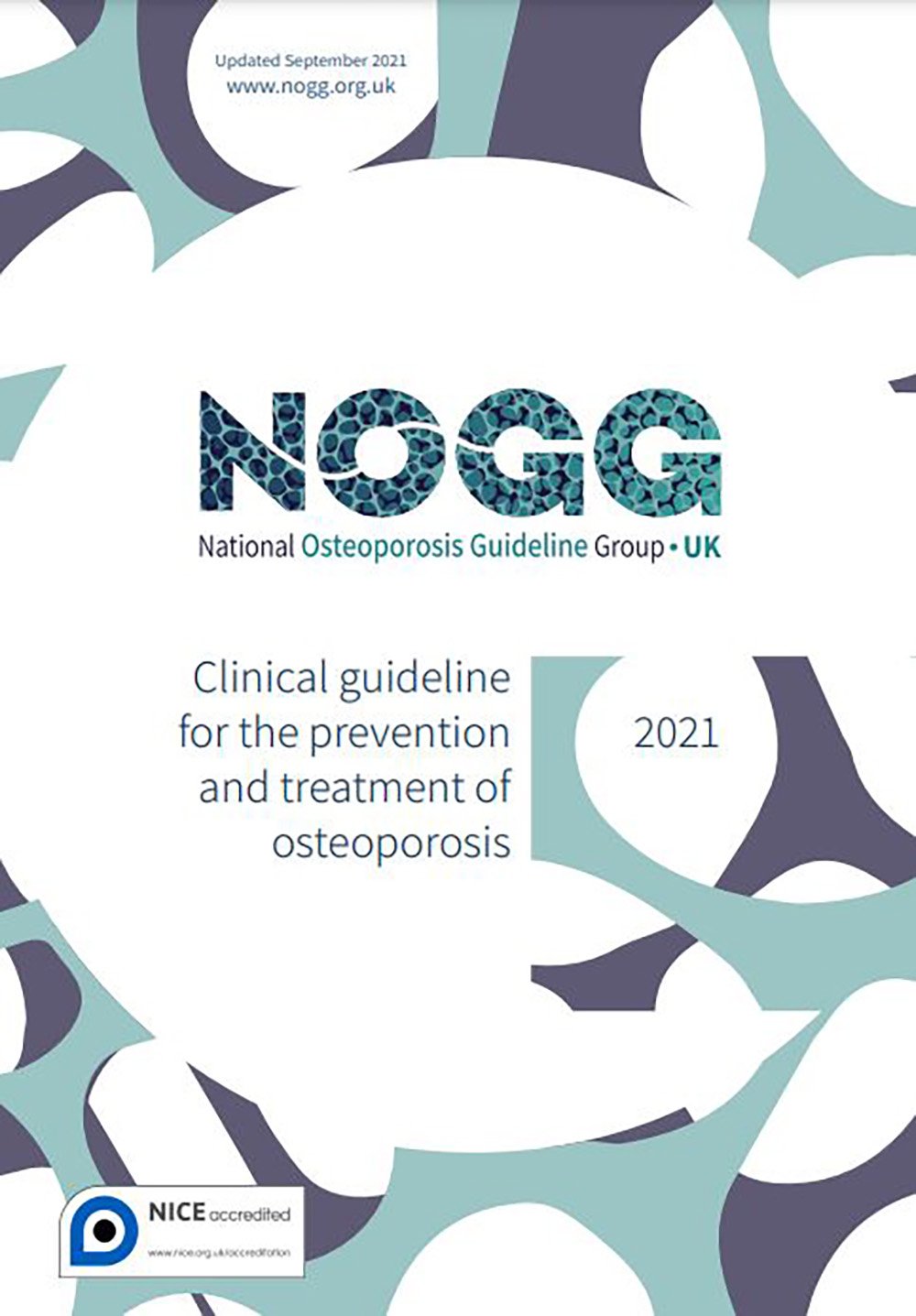Dr Celia Gregson is a Consultant Geriatrician in Bath and Consultant Senior Lecturer in Bristol. She is also a member of the National Osteoporosis Guideline Development Group. She tweets at @celiagregson
Fragility fractures are painful, debilitating, and often life-changing. Older age and frailty convey some of the highest fracture risks, and therefore older people and those living with frailty often have the most to gain from anti-osteoporosis treatment.
In February 2022, the UK National Osteoporosis Guideline Group (NOGG) published the new UK guideline for the assessment and management of osteoporosis and the prevention of fragility fractures in postmenopausal women, and men aged 50 years and older (1, 2). This evidence-based guideline, accredited by the National Institute for Health and Care Excellence (NICE), represented a major update to the earlier 2017 NOGG guideline. The guideline articulated some key points for us as geriatricians, which we summarised in a commentary in Age and Ageing journal (3). Here are my top 10:
- All older people we see in clinic and on our wards should have an assessment of their fracture risk as part of routine comprehensive geriatric assessment (CGA). Check the vertebrae on thoracic and abdominal imaging to detect incidental vertebral fractures and use FRAX; this is usually better than Qfracture, which tends to overestimate major osteoporotic fracture (MOF) risk (4).
- For patients with ≥2 falls in the last year, FRAX-derived MOF and hip fracture probabilities should be increased by 30% (i.e., multiplied by 1.3).
- Because older people have such high absolute fracture risks, the number needed to treat (NNT) is relatively few (5).
- Offer older people with a fragility fracture prompt anti-osteoporosis treatment, because of their high imminent re-fracture risk.
- Where DXA is not possible (e.g., impractical due to frailty), the post-FRAX NOGG graphs helpfully delineate intervention thresholds set at 20.3% for MOF and 4% for hip fracture, with the guideline recommending anti-osteoporosis treatment if fracture risk exceeds either of these thresholds, and/or there is a history of fragility fracture.
- When prescribing oral bisphosphonates to older people, counsel for 10 years of treatment (which may be better phrased as ‘treatment for life’ for those in their last decade). Check tolerance after 12-16 weeks and adherence after 1 year, with fracture risk re-assessed after 5 years (sooner if re-fracture or new clinical risk factors develop).
- Parenteral therapies, including antiresorptive (intravenous zoledronate and subcutaneous denosumab) and anabolic agents (subcutaneous teriparatide and biosimilars, and romosozumab) should be considered in those with ‘very high fracture risk’, indicated by the presence of one or more ‘red flags’. These include a recent vertebral fracture (within 2 years), two or more vertebral fractures (whenever they occurred), a BMD T-score of ≤-3.5, treatment with high dose glucocorticoids [prednisolone ≥5 mg/day or equivalent over 3 months], or the presence of multiple clinical risk factors, particularly with a recent fragility fracture indicating high imminent re-fracture risk.
- Intravenous zoledronate is a first-line anti-osteoporosis treatment, particularly post-hip fracture. Approximately 25% of hip fracture patients will re-fracture over 5 years (6), with half occurring within 18 months (7), so prompt treatment is essential. A single infusion of zoledronate leads to a 23% clinical fracture reduction (HR 0.77 [0.57-1.03]; p=0.080) by 6 months, and 25% (HR 0.75 [0.61-0.92]; p=0.005) by 12 months (8), hence clinical benefit can be realised even in those with a challenged life expectancy, potentially preventing a painful inpatient death.
- Vertebral fracture risk is increased when stopping denosumab, on average 3-6 months after the denosumab injection is missed, attributed to a surge in bone turnover leading to accelerated bone loss. Denosumab doses ought not be delayed, nor should denosumab be stopped without considering an alternative therapy. Intravenous zoledronate is recommended 6 months after the last denosumab injection, but where renal function is impaired and zoledronate is contraindicated, there is unfortunately little evidence to support an alternative approach. Hence, before starting denosumab, a long-term osteoporosis management plan is needed.
- Because bone loss and increased fracture risk occur early after initiation of oral glucocorticoids, anti-osteoporosis treatment should be started at the same time as glucocorticoid therapy, without waiting for bone density assessment, in any woman aged ≥70 years, and any man with a prior fragility fracture or high fracture risk or who is prescribed high dose glucocorticoids (i.e., ≥7.5 mg/day of prednisolone or equivalent over 3 months).
In the first 6 months, the new NOGG website had over 330,000 views, mostly accessed via the FRAX website, with over 20,000 users accessing the full clinical guideline. There were also more than a hundred views of the NOGG website from each of 52 countries, emphasising its international reach. With NOGG guidelines now established, the focus needs to shift to implementation. Osteoporosis services will need to expand and innovate, to provide equitable access to evidence-based treatment to all those in our communities who are at high fracture risk.
References
1. Gregson CL, Armstrong DJ, Bowden J, Cooper C, Edwards J, Gittoes NJL, et al. UK clinical guideline for the prevention and treatment of osteoporosis. Arch Osteoporos. 2022;17(1):58.
2. The National Osteoporosis Guideline Group. NOGG 2021: Clinical guideline for the prevention and treatment of osteoporosis 2022 [Available from: www.nogg.org,uk].
3. Gregson CL, Compston JE. New national osteoporosis guidance-implications for geriatricians. Age Ageing. 2022;51(4).
4. Kanis JA, Compston J, Cooper C, Harvey NC, Johansson H, Odén A, et al. SIGN Guidelines for Scotland: BMD Versus FRAX Versus QFracture. Calcif Tissue Int. 2016;98(5):417-25.
5. Axelsson KF, Wallander M, Johansson H, Lundh D, Lorentzon M. Hip fracture risk and safety with alendronate treatment in the oldest-old. J Intern Med. 2017;282(6):546-59.
6. Balasubramanian A, Zhang J, Chen L, Wenkert D, Daigle SG, Grauer A, et al. Risk of subsequent fracture after prior fracture among older women. Osteoporos Int. 2019;30(1):79-92.
7. Adachi JD, Brown JP, Schemitsch E, Tarride JE, Brown V, Bell AD, et al. Fragility fracture identifies patients at imminent risk for subsequent fracture: real-world retrospective database study in Ontario, Canada. BMC Musculoskelet Disord. 2021;22(1):224.
8. Boonen S, Eastell R, Su G, Mesenbrink P, Cosman F, Cauley JA, et al. Time to onset of antifracture efficacy and year-by-year persistence of effect of zoledronic acid in women with osteoporosis. J Bone Miner Resear. 2012;27(7):1487-93.

